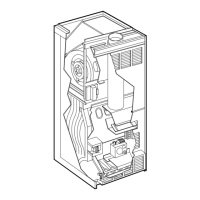Page 5
openings into the vestibule area. Provisions shall be made
for proper operation and for combustion air and ventilaĆ
tion air supply according to the current CAN/CGA-B149
standards.
All electrical wiring and grounding for the unit must be
in accordance with the current regulations of the CanaĆ
dian Electrical Code Part I (C.S.A. Standard C22.1) and/
or local codes.
NOTE Ċ G20R series units must
not be used as a construction
heater" at any time during any
phase of construction. Very low return air temperaĆ
tures, harmful vapors and misplacement of the filters
will damage the unit and its efficiency.
GENERAL
These instructions are intended as a general guide
and do not supersede local codes in any way. AuthoriĆ
ties having jurisdiction should be consulted before
installation.
A-Shipping and Packing List
1-Rubber grommet (for electrical make-up)
1-Base bottom angle
2-Sheet metal screws
B-Shipping Damage
Check unit for shipping damage. Receiving party
should contact last carrier immediately if any shipping
damage is found.
COMBUSTION, DILUTION & VENTILATION AIR
Until recently, there was no problem in bringing in suffiĆ
cient amounts of outdoor air for combustion -- infiltration
provided all the air that was needed and then some. In
today's homes built with energy conservation in mind,
tight construction practices make it necessary to bring in
air from outside for combustion. Consideration must also
be given to the use of exhaust fans, appliance vents, chimĆ
neys and fireplaces because they force additional air that
could be used for combustion out of the house. Unless
outside air is brought into the home for combustion, negĆ
ative pressure (pressure outside is greater than inside
pressure) will build to the point that a down draft can ocĆ
cur in the furnace vent pipe or chimney. Combustion
gases enter the living space creating a potentially dangerĆ
ous situation.
In the absence of local codes concerning air for combusĆ
tion and ventilation, this section outlines guidelines and
recommends procedures for installing G20R furnaces in
a manner that ensures efficient and safe operation. SpeĆ
cial consideration must be given to combustion air needs
as well as requirements for exhaust vents and gas pipĆ
ing. A portion of this information has been reprinted with
permission from the National Fuel Gas Code (ANSI-
Z223.1). This reprinted material is not the complete and
official position of the ANSI on the referenced subject,
which is represented only by the standard in its entirety.
In Canada, refer to the standard CAN/CGA-B149.1 and
-B149.2 installation codes.
Combustion Air Requirements
CAUTION
Insufficient combustion air can cause headaches,
nausea, dizziness or asphyxiation. Excessive exĆ
posure to contaminated combustion air will result
in safety and performance related problems. Avoid
exposure to the following substances in the comĆ
bustion air supply:
Permanent wave solutions;
Chlorinated waxes and cleaners;
Chlorine base swimming pool chemicals;
Water softening chemicals;
De-icing salts or chemicals;
Carbon tetrachloride;
Halogen type refrigerants;
Cleaning solvents (such as perchloroethylene);
Printing inks, paint removers, varnishes, etc.;
Hydrochloric acid;
Cements and glues;
Antistatic fabric softeners for clothes dryers; and
Masonry acid washing materials.
All gas-fired appliances require air to be used for the
combustion process. If sufficient amounts of combusĆ
tion air are not available, the furnace or other appliance
will operate in an inefficient and unsafe manner.
Enough air must be provided to meet the needs of all
fuel-burning appliances, as well as appliances such as
exhaust fans which force air out of the home. When fireĆ
places, exhaust fans, or clothes dryers are used at the
same time as the furnace, much more air is required to
ensure proper combustion and to prevent a down-draft
situation. Insufficient amounts of air also cause incomĆ
plete combustion which can result in carbon monoxide.
The requirements for providing air for combustion and
ventilation depend largely on whether the furnace is
installed in an unconfined or confined space.
Unconfined Space
An unconfined space is an area such as a basement or
large equipment room with a volume greater than 50
cubic feet per 1,000 Btu per hour of the combined input
rating of all appliances installed in that space. This
space also includes adjacent rooms which are not sepĆ
arated by a door. Though an area may appear to be unĆ
confined, it might be necessary to bring in outdoor air
for combustion if the structure does not provide
enough air by infiltration. If the furnace is located in a

